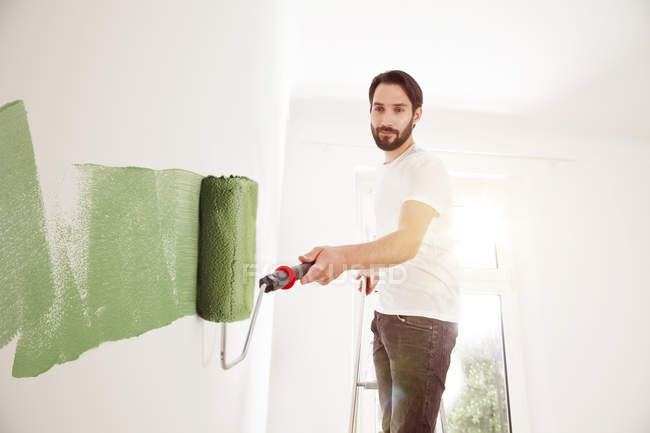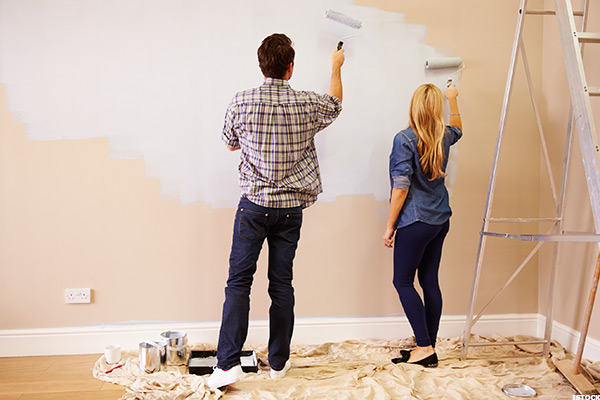Dipping paint brushes and rollers in a can of paint and then slathering it onto your walls sounds easy enough and in concept, it is. Sure, there is a right way of painting that includes choosing colors and buying paint and then there’s the whole surface preparation, which is an important step. However, there are ways to make house painting quicker and easier for both interior and exterior painting.
1. Prepare what you can in advance

- Make a list of all the paints, tools and materials you’ll need and gather all those supplies in one area.
- Clear the room you’re going to paint. For exteriors, move any object that will get in the way of your painting. It will be less tedious for you if you can do this a few days before you start painting.
- Start covering all furniture, lighting fixtures, doors, windows, trims and baseboard. If you’re going to paint over doors and windows, cover the hardware and edges of glass pane with masking tape. For electrical sockets, cover the faceplate with masking tape to prevent paint from getting into sensitive wiring.
- Use canvas drop cloths for carpets. You can double the cloth along the edges that are closer to the wall or use a plastic sheet underneath before topping it off with the canvas cloth. For hardwood floors or tiles, use layers of rosin paper and tape it on to the floor.
- Use self-adhesive plastic film to cover awkward objects.
- Wipe and dust all surfaces so that covers and tapes will adhere better. For exteriors, give your whole house a good wash-down to knock of all debris and any chipping paint. If you own or can get a pressure washer, this will make things much easier for you but a hose will do too. Do this a few days before painting so that the area still has time to completely dry.
The more that you can prepare in advance, the less that you’ll have to do on the big day itself.
2. Spot prime the important areas
While priming the whole house and interior walls is ideal, it can take up a chunk of your time. Unless, you’re painting a lighter color over an existing darker surface or the whole surface has too much stains and rough bumps, then there is no need to prime the whole area.
Instead, look for areas that could really benefit from primer. Take a hint from professional painters and add a bit of topcoat to the primer. This will make the primed surface less obvious.
Similarly, use quick drying filler and caulk for holes, gaps, cracks and obvious damages but don’t obsess over every little imperfection you see.
3. Only scrape the peeling and chipping paint
Scraping paint may seem therapeutic at first but then it eventually leads to more scraping until you realize you’re scraping the whole house. If it’s not peeling and the edges will stay down, don’t attempt to scrape it. The new coat of paint will keep the edges down. Unless you’re planning to really give your house a full makeover, this will do for now. Electric sanders will smoothen the surfaces quicker than sandpaper.
4. Use materials that will make the job easier and quicker
While we’re not fans of gimmicky tools that promise to give you better and quicker results, it’s still best to invest in materials that will make things easier for you.
- Trays are fine to use if you’re painting smaller areas like powder rooms. For larger areas, however, 5 gallon buckets are better. Boxing the paint by mixing all the paints you’re going to use on one area is ideal especially for exterior painting. This will make sure that your paint color stays consistent.
- Pair your bucket with a paint grid to quickly remove excess paint.
- Add an extension rod to your roller. Any long rod can be used to attach to your roller, like a handle snapped off from a broom but extension poles that can be extended up to 6 feet are also available in hardware stores.
- Good quality brushes may seem like a waste of money but it actually goes a long way before you have to replace it. A rubber grip may also feel more comfortable than a wooden gripped brush and will make it easier and gentler on the hand for long hours of painting.
Save the expensive brushes for the interior where it’s more likely to be viewed by judging eyes. For exterior painting, go with easily replaceable and cheap foam rollers and nylon brushes. Use a paintbrush comb while washing it with water. Wrap your brushes tightly with plastic to avoid paint hardening.
- Use disposable paint pail or tray liners for easy cleanup. Choose the eco-friendly ones so that you’re doing Mother Nature a favor too.
5. Roller brush everything you can
If your house has a flat siding, you can cover it with paint quickly using a roller brush. However, not all houses have flat siding and you might want to consider hiring pros if the architecture of your house is much more detailed.

6. Use the same existing color or a darker color to cover the old paint
If you’re DIY-ing all the way and just want a quick fresh look for your house, paint it in the same existing color. Take a chip of the existing paint and bring it to a paint store so they can find the right color match. If you want a change of color, find a slightly darker color than your existing paint shade to cover it up.
7. Learn how to paint properly
Painting may sound so simple that anyone can do it but when you’re actually painting it on the walls, you’ll realize it’s not as simple as it sounds that is why a lot of house owners choose to hire a painting company . Learning the right technique can make things easier and quicker without having to do over everything.
When painting a wall, painters use a technique called cutting-in where corners and edges that are too tight for a roller brush are painted with a paint brush. Once all the corners and edges are cut-in, take a roller brush and dip it into your bucket, start by painting downwards, then roll upwards by spreading the paint and touching up on the corners that you cut-in.
While all these tips are useful, if your house is too intricate and detailed, it is still better to hire a painting contractor to do a more professional job especially if you’re planning to sell your house. If you want a quick and easy job, you can do the painting yourself but if you’re after a much better upgrade or if your house’s paint is too old and outdated, consider hiring a pro to take care of everything for you.







